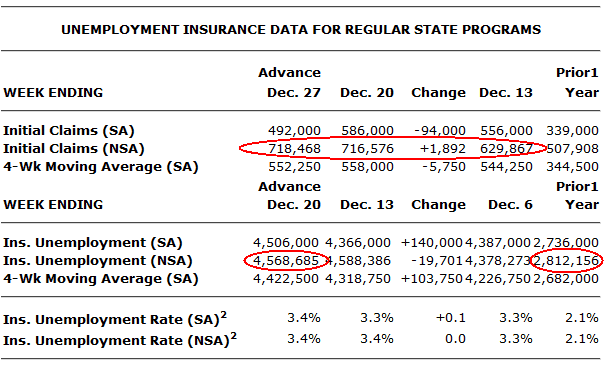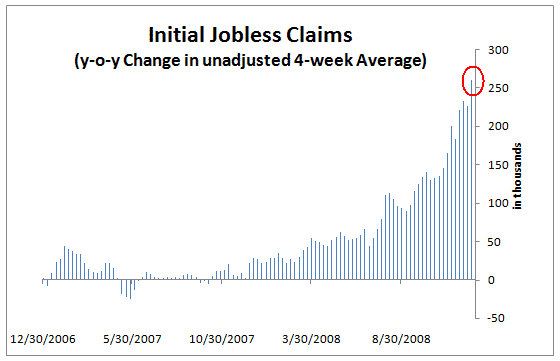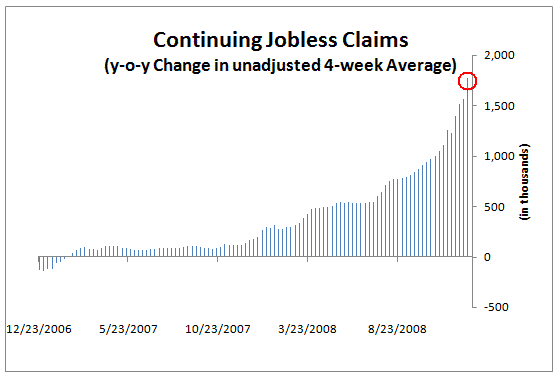Jobless claims end year nicely under 500,000
U.S. Initial jobless claims fell a massive 94,000 to end the year at 492,000 last week. It was nice to see a sub 500,000 jobless claims number to end the year after an ugly November and December. However, one should note that the fine print is not as good because this number was completely dominated by seasonal adjustments. The actual unadjusted number of 718,468 was actually higher than last week’s actual unadjusted 716,576.
Here is how Reuters reports it.
The number of U.S. workers filing new claims for jobless benefits slumped 94,000 last week, government data on Wednesday showed, but seasonal factors were likely behind this unexpectedly large decline with the labor market remaining very soft.
Initial claims for state unemployment insurance benefits fell to a seasonally adjusted 492,000 in the week ended Dec 27 from an unrevised 586,000 the prior week, the Labor Department said. It was the lowest reading for initial claims since the week ended November 1, 2008, and the steepest decline since 1992.
Prices on U.S. government bond extended losses on the larger-than-expected drop in claims.
Analysts polled by Reuters had forecast 565,000 new claims as the country’s year-long recession continued to chill employment, and a separate reading on so-called continued claims hit a 26-year high.
A Labor Department official said the timing of the year-end holidays and volatility in factors used to seasonal adjust the data was likely to blame for the large decline in initial weekly claims, and he warned this situation could persist for several more weeks.
“The numbers seemed unbelievable but the states certified they were correct,” the Labor Department official said.
The numbers are indeed unbelievable. Why? The seasonal adjustment factor for initial claims was 145.9, where 100 means the adjusted and unadjusted numbers are the same. That means taking the real number and dividing it by 1.459. That’s a huge adjustment.
If you look at the chart below, which strips out these anomalies by comparing the 4-week average unadjusted numbers to last years numbers, you can see that the comparisons are at their worst for this cycle.
The long and short of it is that the numbers are skewed by seasonal adjustments and do not represent the picture on the ground. In reality, the U.S. job market is looking bleak.
Sources
Jobless claims drop by much more than expected – Reuters
Unemployment Insurance Weekly Claims Report – Department of Labor



Ahh seasonal adjustments. A fine way to smooth over a dodgy figure. I wonder what on of those 718,468 would have to say about "seasonal adjustments"? Either way, it's bad and accelerating at a rapid rate. Any one for an 09 recovery?
There is a tremendous shortage of skilled labor in this country. We need doctors, lawyer, scientists and anyone who can do basic math. Open the borders to immigration. More h1b visas! The workers will buy homes and stabilize the real estate market.
Why not use some of that $850 billion to up-skill some of the 718,468 workers put on the scrap heap instead of importing more workers only adding to the countries infrastructure and environmental problems all the while you still have to deal with the 718,468 unemployed. It's extremely short sighted to import workers to fix a problem when the nation has an abundance of under skilled workers capable of filling positions with additional training. In doing so, they could retain the jobs, houses etc and most importantly the confidence to invest and borrow. Returning confidence to the market will come about with confidence in job security.
I'm of two minds here. When I was a diplomat for the foreign service in the early 1990s, I issued a bunch of visas (junior diplomats work in the visa section first). Having seen the process in its entirety, I was thoroughly convinced that the present immigration policy is broken. That's a debate for another day.
But, what I did realize is that a lot of people wanted to come to the U.S to visit. Many of them were skilled workers. And, it was at my total discretion as to whether they could do so — at least as visitors. In issuing visas to students, I felt that it was my 'duty' under the law to allow qualified J1 (student visa) applicants a chance for an education. The question was what happens when they graduate from school.
To my mind, one must expect a young adult who spent their formative years in the U.S. studying to want to stay on. And I was cognizant of this whenever I issued a student visa. I imagined I was issuing a student visa to someone who was probably going to stay in the U.S. and add to our population. And, if they are well-educated and skilled, that's a bonus for the U.S. and a potential loss for their home country.
The issue of brain drain is a topic for another forum. But, the crux of what I am saying is that foreign skilled workers only add to America's potential. Why restrict them 'excessively.' Unskilled workers are another question altogether.
But, Glen, I agree with you that 'importing' workers for the express purpose of 'fixing' a shortage of skilled labor shows short-sightedness. It is one reason why the U.S. must invest in education or upskilling as you suggest. So, to sum up, don't increase H1B's in order to meet a temporary shortfall of skills unless you also invest in promoting those skills amongst future U.S. workers in schools. But, don't restrict the inflow of skilled workers; they only add to America.